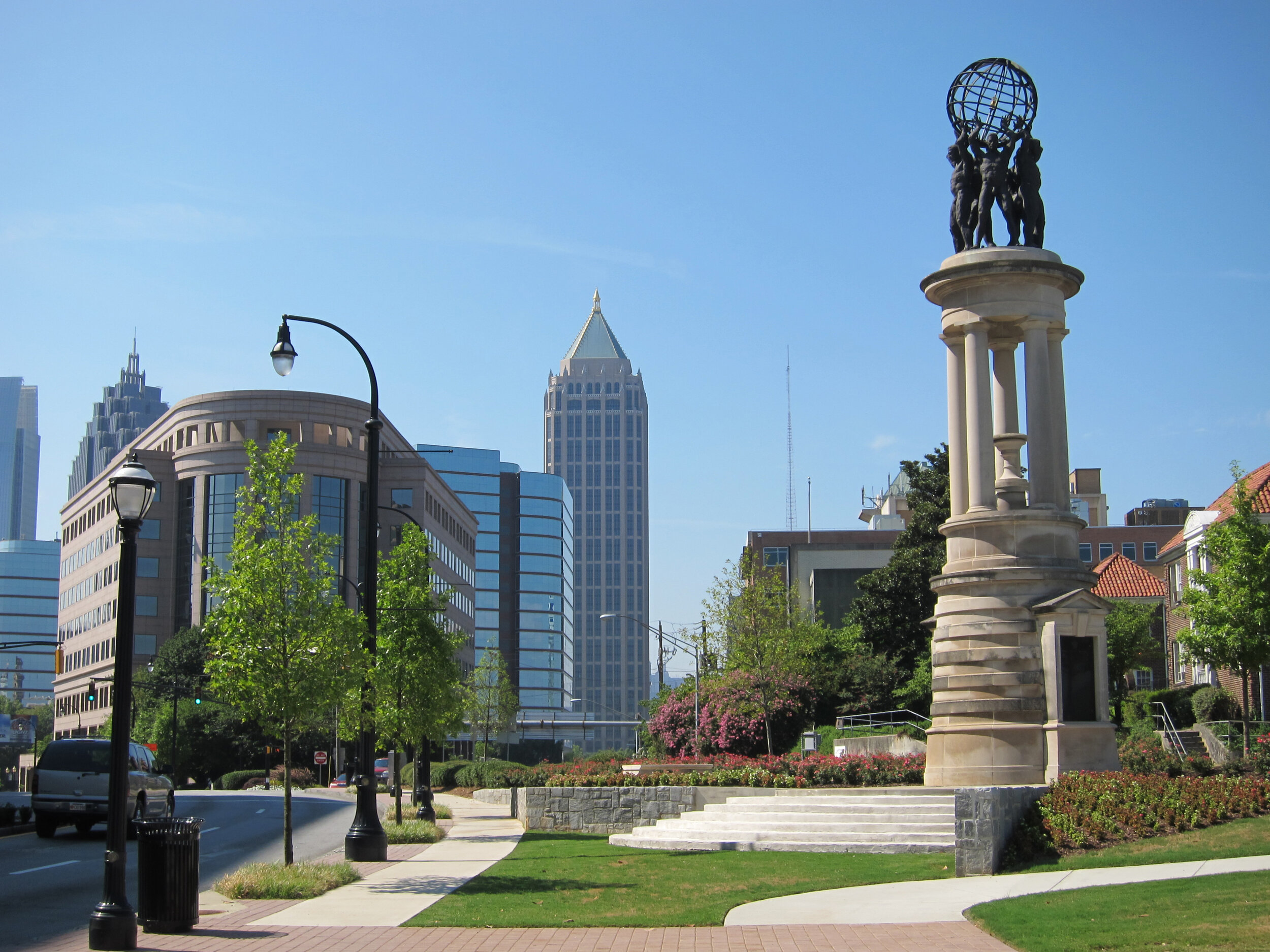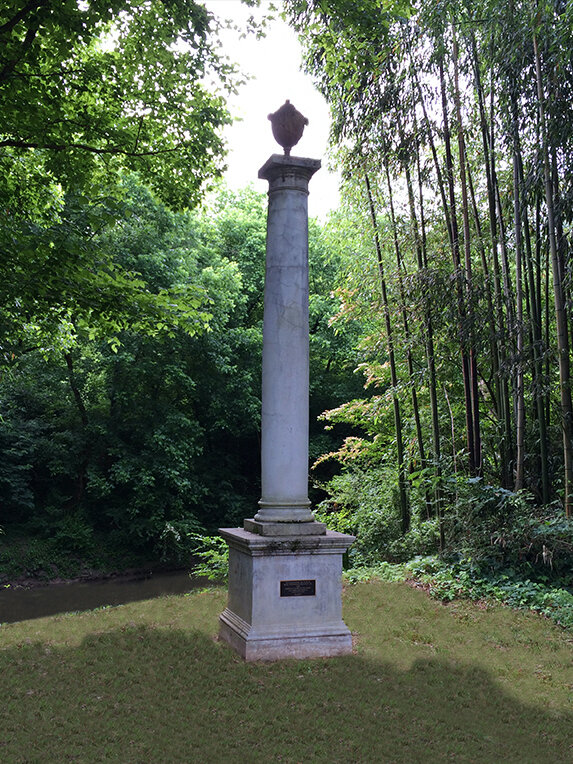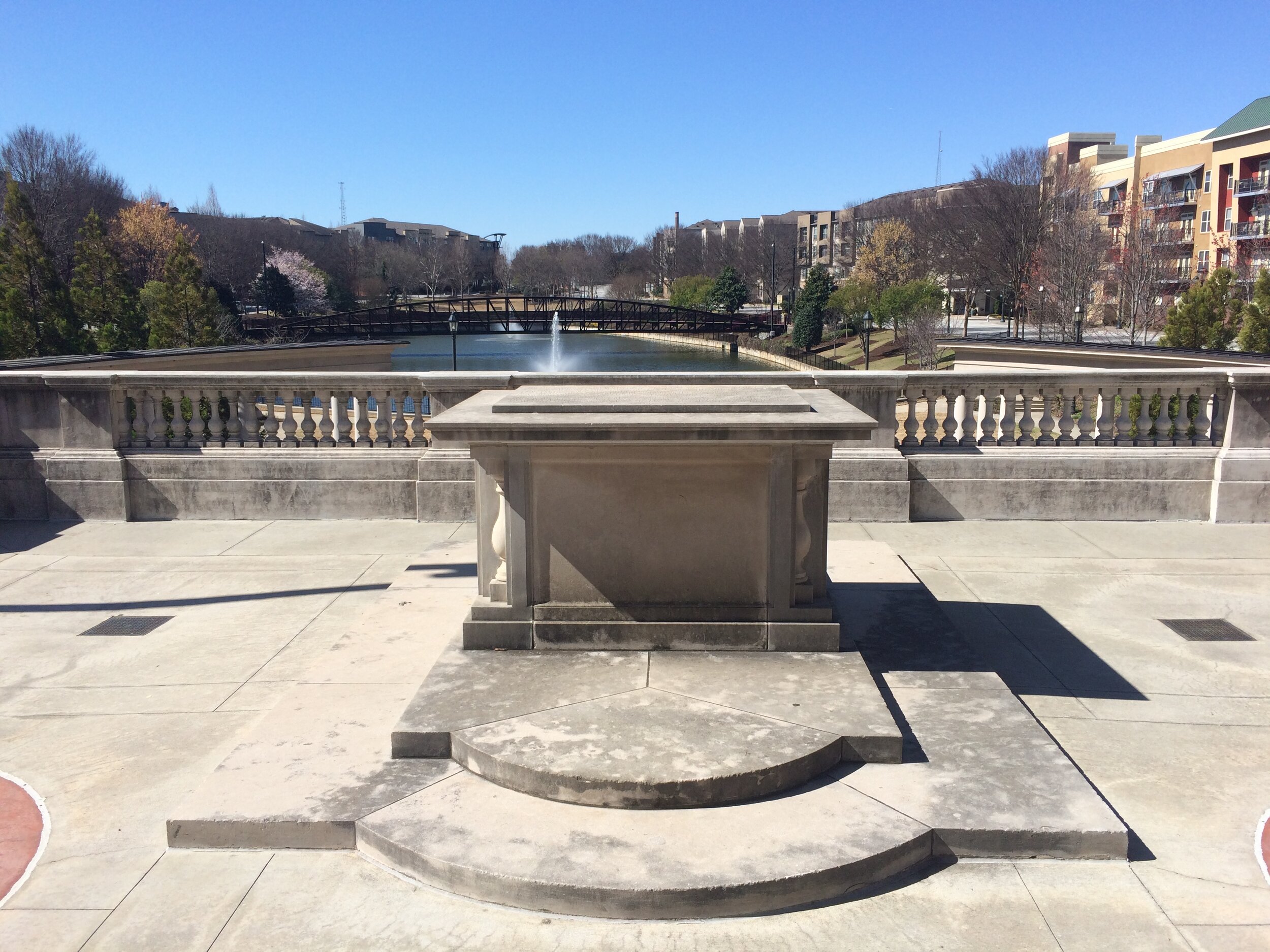
The Prince of Wales’s World Athletes Monument to the Centennial Olympic Games
The World Athletes Monument, more commonly known as the Prince Charles Monument or Prince of Wales’s Monument, is located at Pershing Point in Midtown Atlanta, Georgia. The monument, dedicated to the 1996 Summer Olympics, is a gift from the Prince of Wales. It is carved in Indiana limestone, topped by bronze statues, and stands 55 feet tall. It has a conical base circled by five stone bands which have two aedicules on the Peachtree Street axis, within which are plaques honoring the patrons who built the building. Above the base is a tholos supporting five Doric columns, representing the five continents, which support five bronze figures of Atlas who together carry a globe. A cauldron within the tholos emits a fire evoking the Olympic torch. Taking advantage of the avenue being straight for a number of blocks, which is unusual in Atlanta, the monument was intentionally aligned with the tower of the 19th-century Gothic Peachtree Christian Church a few blocks away.
The Prince of Wales's Institute of Architecture held an international competition for the design of the monument. The competition was won by Anton Glikin, a St. Petersburg, Russia architect and Institute student. The land was donated by the Georgia Department of Transportation. With the lead donation from the Randall family of Atlanta, construction began. The monument was dedicated during the Centennial Olympic Games by Lord Morris of Castle Morris representing Queen Elizabeth II. On August 31, 1997 Diana, Princess of Wales, was killed in an automobile accident in Paris. During this time, CNN estimated over 20,000-30,000 people were drawn to the World Athletes Monument to grieve and pay their respects. Flowers, candles, and mementos were left at the base of the building rising to 6 feet in height. The mourners remained on the site sleeping in the street and on the plaza for the week leading to the live broadcasted funeral of the Princess of Wales. The Atlanta City Council shortly thereafter dedicated the space as the Prince of Wales’s Monument at Princess Diana Square.
On June 5, 2004, President Ronald Reagan died and once again thousands of people congregated around the World Athletes Monument to grieve. The monument was again enshrouded with flags, candles, flowers and other mementos. It has also become a gathering place for sports victories and other civic uses the citizens of Atlanta choose to celebrate. The New Yorker Magazine has indicated that this monument has impacted the soul of the citizens of Atlanta unlike any other in its history.
Midtown Gates
The gateway between Midtown and Buckhead as you travel north on Atlanta’s principle avenue, Peachtree Street, are represented by obelisks at Brookwood Train Station. They align with the Shriner’s Temple and the west obelisk is dedicated to Bess Mims Cook, whose home was on the site of the Shriner’s Hall in the latter 19th and early 20th centuries. The Mims family have been patrons of the city of Atlanta for 175 years.
Millennium Gate
The Millennium Gate is a classically styled monumental arch located in Atlanta, historically called “The Gate City.” It was inspired by the plan for the Washington D.C. Millennium Gate at Commodore Barney Circle. It is designed in the tradition of classical Roman triumphal arches that have been built around the world over the past 2,500 years, and houses a 12,000 square foot museum that narrates Georgia’s history through sophisticated interactive technology, film, period rooms, and exhibitions. The museum is a 501(c)(3) non-profit charity and a winner of the Palladio Award for design of a public space in the United States. The NMF technology in the interactive Philanthropy Theater has won the Technology Association of Georgia’s Excalibur Award. We have educated over 1,000,000 Georgia 8th graders with this technology.
The Peace Column
The 115-foot tall Peace Column in Rodney Cook Sr Peace Park will be topped by a statue of Chief Tomochichi of the Yamacraw Tribe, considered Georgia’s co-founder with General James Oglethorpe. Tomochichi chose peace rather than massacre the British colonists, thereby beginning Georgia’s 300-year tradition of peace. The base of the Peace Column will house a museum focused on peace leaders from Georgia, including Civil Rights peacemakers from the surrounding Vine City neighborhood who changed the world. Exhibition galleries will be constructed within the pedestal of the structure. The museum will house the 8,000 volume CT & Octavia Vivian Library and the 3,000 volume King family library. This is the largest collection of African-American literature and dates back to the 18th century. Dr. Vivian read every single book in his collection, some several times. It is no wonder Dr. Martin Luther King Jr. said C.T. Vivian was the finest preacher who ever lived.
Cenotaph memorial column to
John F. Kennedy, Jr.
Situated in a bamboo grove at Alexandra Park, which he enjoyed, this cenotaph commemorates the lives of John F. Kennedy, Jr. and his wife Carolyn Bessette Kennedy. Kennedy was a visitor to Alexandra Park and particularly liked morning runs along the trails through the large Asian bamboo groves.
Atlanta Memorial Cenotaph
The cenotaph honors Atlantans who died before their time. Plaques commemorate fatalities during the Siege of Atlanta, the Winecoff Hotel Fire, and the plane crashes at Paris Orly Field and Mount Kenya among others.
Vietnam War Memorial
This cenotaph is dedicated to the Vietnam Veterans from Georgia who died in service to their nation. A full military honor ceremony took place with over 1,000 participants and included aircraft and helicopter fly-overs. The Vietnam Veterans Association placed cenotaphs throughout Georgia to recognize each veteran lost in battle. This was the last one to achieve their goal and recognizes Sgt. Preston Tribble, Jr.
Millennium Gate Rostrum
The rostrum at the Millennium Gate reads:
NOVUS ORDO SECLORUM
The Millennium Gate is dedicated to peaceful accomplishments that have shaped the Western World, the United States, and the city of Atlanta over the two millennia since the birth of Christ. A symbolic portal into the city, the ensemble refers to the Egyptian, Greek, and Roman civilizations, the foundations of western culture. The statues of Justice and Peace represent Egypt and Greece respectively. The arch represents Rome and is based on the Arch of Titus.
Cities are the engines of contemporary society and citizens are obligated, to the best of their abilities, to make their city better than the one in which they were born. Eighteenth Century Georgia, one of the thirteen original colonies, led to establish this tradition and heritage in America. Her citizens first created the sublime city of Savannah, one of the world’s most extraordinary urban plans. In making any of our cities more beautiful, we nurture our children and grandchildren; we honor our ancestors, our history, and ultimately God. This we have tried to do at the Millennium Gate.
The United States of America, at this significant date, has risen to the greatness envisioned by our founding fathers. The New World has eclipsed the Old; our Republic has surpassed the ancients’ and has established a high standard to which future cultures can aspire long after we are gone. In celebration, the twenty-first century National Monuments Foundation and her patrons gift this arch to the people of Georgia and her capital, Atlanta. The Millennium Gate is built in the hopes that we may, in the words of Plato and Jefferson, become ennobled through the nurturing qualities of beautiful architecture.
Rodney Mims Cook, Jr.
Princess Royal Monument
The Princess Royal Monument was built to commemorate the turn of the millennium visit of HRH Princess Anne to Alexandra Park in Atlanta. It is dedicated to “all architects and craftspeople who through real effort have created beauty.” HRH celebrated the event with the smashing of a champagne bottle when the monument was unveiled.
































